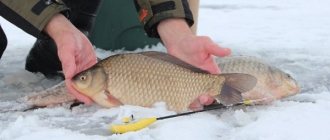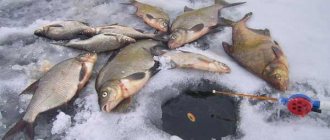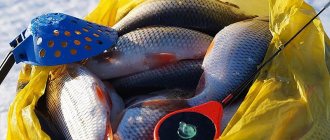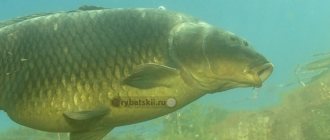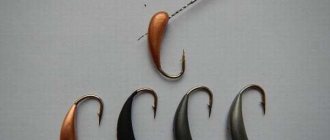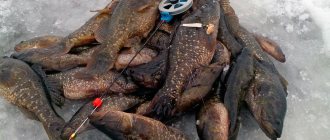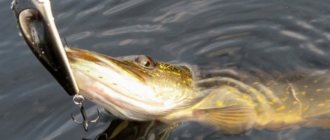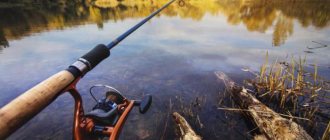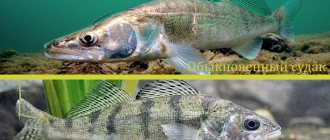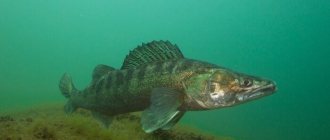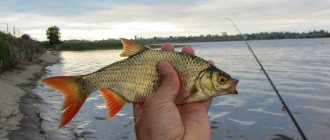The best jigs for pike perch
It is believed that fairly large jigs will be most effective. If you take them of medium or small size, you will still have a chance to catch some pike perch, but only fairly small specimens can be caught.
Most often they use devil or ural jigs . The color is silver, golden or black. It is preferable to use the Uralochka from sizes ten to fourteen, and take the largest possible size devil. The hooks on jigs must be strong and extremely sharp.
Only in this way will it be possible to effectively hook the fish.
With or without a nozzle?
The most common option is when a nozzle is used. When fishing for pike perch, this option is considered to be the most effective. However, nozzle-free options, along with nozzles, are also used and can be quite effective.
It is difficult to advise what to choose, since it depends on the specific characteristics of a particular fishing trip. Experience may be the best advisor here. As it accumulates, the fisherman will be able to make this choice more and more accurately.
A small fish can be used as a bait . It is also quite acceptable to use silicone fish.
Photos of jigs with your own hands
Read here - DIY fishing net - weaving patterns, net options and tips on how to tie a strong net quickly and easily (145 photos and videos)
Winter jig for pike perch
The jig itself is a common method of catching fish. But, if you need to catch pike perch, the bait must be special, suitable specifically for this type of fishing. Usually in winter, all the equipment for catching this predator is selected in a special way. This is due to the characteristics of this type of fish.
For this purpose, jigs are larger than others and can weigh up to 30 grams. Not just any rod is suitable here either. Here, special attention is paid to its rigidity and strength, because pike perch is a large and strong fish. It is recommended to take fairly rigid tackle of a meter in length. At the end the thickness should not be less than three millimeters.
You will need a strong fishing line. Its thickness depends on the depth at which you intend to fish. If it does not exceed 8 meters, then it is recommended to choose a fishing line with a thickness of 0.18 millimeters . If the walleye is expected to be deeper, then it should be thicker. In this case, it is customary to use a fishing line with a diameter of 0.25 millimeters.
The rod must be equipped with a nod. One of the most convenient options is to make a nod from a clock spring. They are also sometimes made conical, with a metal line ring at the end.
The reel should be used without inertia and the line should be of sufficient length. Although it happens that pike perch can be caught at a depth of less than 8 meters, however, in most cases, fishing takes place at much greater depths. It is not uncommon for cases to be ten meters deep or even greater.
A telescopic rod is also sometimes used. It has the required strength, while maintaining relative lightness and elasticity.
How to choose gear
A fishing rod for winter fishing for pike perch, or rather, its appearance does not play a significant role, but it is advisable that it be with a reel. A more significant factor is the thickness of the fishing line, which must be of sufficient length and have a diameter of at least 0.1 mm, or better yet, 0.2-0.3 mm. It is important that the fishing rod is equipped with a nod.
It is he who guarantees smooth play of the tackle. Experienced fishermen recommend choosing nods with maximum sensitivity. This is explained by the fact that pike perch, by their nature, does not immediately swallow bait. He likes to gently touch it, casually, and only then grab it. A sensitive nod is the key to successful fishing for pike perch from the ice in winter.
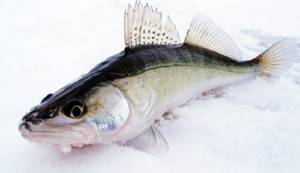
There is a passive way of fishing - this is when you make one maximum of 3 holes and sit quietly and catch without running around and fuss, just admiring the winter landscapes.
Of course, the most effective method is considered active since it gives the best results. Because of this, passive is more like relaxing than fishing. The process itself is important here, not the result. Although the passive one sometimes shoots, so don’t worry, mom.
The sprat itself is a rather old bait. But in the modern world it is very rarely used. Because there is some kind of disgust towards this fish.
Well, tell me, why does a real fisherman go to buy fish so as not to catch it later? Then your hands stink. You still need to hook it correctly. Isn’t it easier to buy a silicone fish and fish for yourself without any problems? And let fools and beggars who don’t have money for normal bait catch fish with sprat. Something like this can be heard.
But my dears, this is far from the case, maybe someone will disagree, but I will say we all know what happened on any body of water where there is pike perch with the advent of such baits as spoons, spinners and ratalins. The pike perch grabbed these baits like crazy. After a year or two, the excitement dropped, and the pike perch got smarter; now it’s not so easy to catch it. It was necessary to somehow manage and dodge.
Basically, to search for pike perch, fishermen go in a group and methodically drill holes, then together they begin to fish for them. You shouldn’t stay in one place for a long time; you need to actively search for fish, periodically returning back.
A more passive fishing option involves searching and drilling holes along the edge of the channel, waiting in a certain area for a school of pike perch to pass.
You can also use a winter spinning rod as a fishing rod, equipped with an inertia-free reel with the same line and nod as when using a winter rod with an open inertia reel.
For both types of rods you will need a suitable stand, since in some cases pike perch is caught using sprat in a passive way.
Catching pike perch with sprat involves the use of two main types of rigs with variations - rigs on a retractable leash and rigs on a jig, jig head or loaded rig.
The principle of equipment is very similar to a retractable leash for spinning or bottom fishing. A sinker is tied to the end of the main line - its weight is selected depending on the depth and current, on average it is 12-18 grams.
A monofilament leash 5-10 centimeters long is tied approximately 20 centimeters above the sinker. Equipping a leash usually involves three options.
In the first option, a plastic phosphorus jig with a long hook is tied to the end of the leash, the size of which is selected to match the size of the fish so that after baiting the hook is located approximately in the middle of the bait.
We invite you to read: How to grow crucian carp at home?
Rod
The rod should be comfortable, strong, with a powerful whip capable of absorbing the jerks of a large trophy when fishing. The same element also affects the quality of hooking. The mouth of the fanged one is hard, and in order for the hooks to be able to penetrate it, the hook must be strong and sharp.
Coil
The reel needs a large size. In winter, fish prefer to stay at a considerable depth, and this is taken into account when winding the fishing line.
It is not advisable to use wicker in winter. It quickly freezes, becomes covered with pieces of ice and begins to get tangled.
When installing, it is better to exclude metal elements (swivels, carabiners). Even if there is a chance that a pike will bite, it is better not to use a metal leash.
The pike perch senses it well and quickly gets rid of such bait.
Hooks
There are many types of gear for catching pike perch using sprat; in different conditions, anglers use different solutions. But basically all gear can be divided into two types: for stand-up fishing and for active fishing with one fishing rod. Typically, gear for catching pike perch in winter using sprat is made by fishermen.
The active method is similar to winter glitter. And this method is the most catchy. Standing rods can work well:
- When fishing at night in areas where pike perch are actively feeding;
- When placed on trails where fish move from parking areas to hunting areas and back.
But she still needs to be found. It's easier to do this in an active way.
You can combine it - actively search for fish, and in case of a bite, place several stands in the zone. In addition, today the fanged one can take on twitching, and tomorrow - only on a standing sprat.
In the deepest winter, it is better to place only the tail on the hooks. The following combined tactics work best.
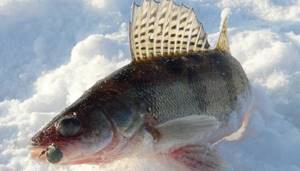
It’s possible to catch pike perch on sprat in winter using the following gear:
- On a fishing rod, for sheer trolling.
- To the girders.
- On postavushi.
The role of the dead fish, in this case, is relegated to the background, since the entire fishing process is aimed at using artificial bait, such as:
- Spoon.
- Balance.
- Amphipod.
- A tube.
- Silicone.
- Rattlin.
Catching pike perch with sprat in winter requires the following skills:
- identify habitats;
- know habits;
- selection of gear and baits.
You can also bait a dead frozen sprat onto the hook of a zherlitsa; such tackle is called a postavusha. From time to time you need to approach her and jump up.
We are preparing the tackle. Take a rigid fishing rod 50–70 centimeters long in order to pierce the jaw of a pike perch that has bitten at a depth of 10 meters. It is advisable to equip the bit with an aluminum reel; it lasts longer and is more reliable. The nod is at your discretion, but in accordance with the sinker used.
Fishing with a jig
And now about the hooks and methods of installation for this gear. A few years ago, when fishing for pike perch with sprat was just coming into use, everything was simple and clear. Jig - a head from 15 to 20 grams, above the main fishing line a jig was tied - a boat with one large hook and a sprat was attached behind the eye. Subsequently, fishermen tried to improve the equipment.
Many people use this scheme: fishing line 0.25 - 0.35; lead jig, coated with phosphorus or painted in a bright lemon color; an additional leash 15 -20 centimeters long at a height of 20 - 30 centimeters from the main jig, equipped with a plastic jig with phosphorus filler and a necessarily long shank of the hook to attach the sprat along the entire length of the back.
Pike perch is caught mainly with the upper jig, and rarely takes the lower one. The lower jig head or jig can be replaced with a weight with a swivel or a “Cheburashka”.
When fishing for fish from a hole, the lower jig is hooked onto the ice; it is recommended to make the leash 5 centimeters long from a fishing line of the same diameter or a little thinner. A short leash maintains the sensitivity of the tackle, regardless of which side the pike perch attacks from.
When fishing for pike perch, baits with baits and baitless options are used. The following can be used as attachments:
- bloodworms (pieces or several at once);
- pieces of lard;
- pieces of fish;
- frozen sprat;
- silicone baits.
A fishing rod can have different types of nods. Some fishermen use a spring, others install a plastic version. As for the fishing line, in this case it must be threaded through the nod. This ensures the most sensitive play with the jig.
If the type of fishing rod when fishing for pike perch in winter is not important (but it’s still better if it comes with a reel), then the thickness of the fishing line is important: the thinner and more transparent the fishing line, the more bites there will be. Usually choose a fishing line with a diameter of 0.1 to 0.3 millimeters, and long enough.
Features of catching pike perch with a jig
Strong tackle is needed due to the fact that this fish is strong, with hard scales. If a bite occurs, you need to hook as hard as possible so that the fish gets hooked. To be sure to pierce the mouth of this fish, it is best to hook it in a sweeping, forceful manner.
This is why you will need strong tackle.
Now let's tell you why the nod is needed here. The fact is that in winter, pike perch, before taking the bait, tries it, lightly touching it with its cheek. With a good nod you can feel it and use it.
How to play when catching pike perch with a jig?
In winter, this fish does not like sharp and fast play. Pike perch prefers a smooth and slow game. This is exactly the kind that can attract him and make him attack the jig. The slow movement of the bait hypnotizes it to some extent and can make it pounce on the bait.
Let's talk about one way to play with a jig, which is considered quite effective:
- First she sinks to the very bottom . After this, you need to gradually remove the slack from the fishing line. This should be done while avoiding strong and sudden movements if possible.
- After this is done , you need to raise the jig about five centimeters above the bottom of the reservoir. Then we sharply lower the bait and wait about ten seconds.
- After this, with slow and very smooth movements, we gradually raise the jig by about thirty centimeters.
- When lifting, it is advisable to do slow rocking . If you are fishing with devils, then there is no need for such swaying.
This game must be repeated several times. It is usually believed that this needs to be done ten times. If no result is observed, then you will need to do the following. At the same time, the style of play changes slightly. To do this, raise the bait by about ten centimeters. After rising, you need to wait for five seconds.
Then they play with slow movements and use sweeping movements. After doing this several times, you will most likely get the predator to attack your jig.
During the fishing process, you will notice that bites mostly occur when using very specific elements of the game. If you can notice a similar pattern, you can use it in the future.
The step game is also sometimes used. To do this, lower the jig to the bottom and play as described above. If the result is unsuccessful, lower the bait to the bottom again and remove about thirty centimeters of fishing line. The jig moves a little further downstream.
Fishing rod with retractable leash
This may be the same “swinger” that was just used to catch pike perch using a spoon, but it is installed near the hole in a stationary mode, that is, as a fixed tackle that catches fish without the participation of the angler. The fishing rod is fastened in wet snow, the handle is frozen into it so that the fish does not drag away the tackle. A feeder bell is attached to the nod, which will signal a bite to an angler located nearby. Even fifty meters away you can hear the strumming of a bell. You just need to hurry up and run to the tackle in order to hook it in time.
A sinker is lowered to the bottom, above which a diverting leash with a jig is attached, which glows better, especially when fishing occurs at a depth of 10-12 meters or at dusk. And at dawn or in the evening a trophy pike perch can take it. The length of the lead is usually 40-60 cm. A slice of fresh sprat, preferably with a tail, is attached to the hook of the jig. A jig oscillating in the current attracts a predator with its movement and vibrations, and cut sprat attracts a strong smell. Self-catching gear does not scare away the fish, as happens when there is a restless fisherman nearby, knocking on the ice with a drill, a fishing box, feet in shoe covers, casting a shadow. And such gear is often more effective than fishing with active baits with a spinner rod and balance beam.
Read! Catching large pike perch
Where to look for pike perch in winter?
When fishing in the dead of winter, it is necessary to take into account that at this time the fish prefer to live at depths. At this time, her behavior is passive and there is little that can cause hunting excitement. The good news is that the places where these fish feed are generally well known.
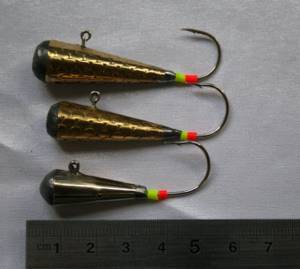
Fishing in these places will be the most promising. The most important thing is not where to find pike perch in the middle of nowhere, but how to make him want to attack the bait.
It usually lives at depth in river beds, where there are snags at the bottom. Where the water is running, pike perch prefer places with relatively slow currents . It can also be argued that places where there are sharp changes in depth are attractive to him.
Of course, the question naturally arises: is it possible to accurately detect the habitats of this fish? Unfortunately, there is no exact list of signs that will reliably point to such places. The ability to determine them is indirect and mainly based on experience. An exception may be two categories of fishermen.
Some of them are the happy inhabitants of the echo sounder. Others are those who know the body of water where they catch walleye extremely well. With many years of experience, they may well gradually find those places where fishing for pike perch in winter is very promising.
In practice, it is customary to roughly determine possible fishing spots, and then drill the required number of holes in different places and try your fishing luck in several of them. Of course, over time, the chances of finding a good place will gradually increase.
However, at first, you may have to make a lot of attempts until luck smiles on the fisherman.
It also makes sense to try places such as holes or elevated areas of the bottom, places where there are snags. It should be taken into account that it is unlikely to find promising places in shallow water. Another good sign is the presence of clean and clear water.
If there is no current yet, then such a place may well be where you can catch pike perch.
If you fish on the first ice, and not in the dead of winter, then the chances of a good catch increase sharply. At this time, the fish are highly active. However, the ice during this period is very thin and walking on it is very dangerous.
Another important factor may be the time of day. The best bite occurs in the dark and before dawn.
Another useful fishing technique can be a joint search by several fishermen. The combined effort will allow us to cover a much larger area in the process of finding places for successful walleye fishing.
Winter zander baits
They can be divided into two large groups:
- When used with attachments. They can be either natural or synthetic.
- No attachments required.
White baits or one of the phosphor colors have proven themselves to be quite good. When choosing them, it is best to take the largest size that is available.
- If fishing will take place in calm water , where there is no current, you can use lead jigs. Where the current is strong, a tungsten bait is more suitable. This is due to the fact that in the latter case the weight of the jig will be much greater than that of a lead jig of the same size.
- The form of bait that has proven itself best is a droplet-shaped jig.
- There are no strict restrictions on color , but the most popular colors are silver, white, yellow or black.
- When selecting a jig, you must pay attention to the hook. It should not be thin and weak. For catching pike perch, only a strong, reliable and razor-sharp hook is suitable.
- A good additional option is to use cambrics or beads on a hook. They help to attract fish to a greater extent and, at the same time, somewhat change the game of the bait.
Lures
Jigs for pike perch are large and heavy, usually from 7 to 35 grams. At greater depths and currents, ordinary summer jig heads are used. The most commonly used baits are drop-shaped baits and cones. A distinctive feature of pike perch jigs is their horizontal suspension (fully or at an angle). It is in this position that the nozzle is placed correctly. If possible, it is better, instead of jig heads with straight hooks, to use special winter jigs for pike perch, in which, due to the bend, the hook is located at a sharper angle to the vertical of the suspension - the tail of the fry, when such a bait is on the bottom, looks up, as if a fish buried her head in the bottom and was looking for something there. The most catchy jigs for pike perch for winter fishing have exactly this shape. Often fishermen make jigs for pike perch with their own hands.
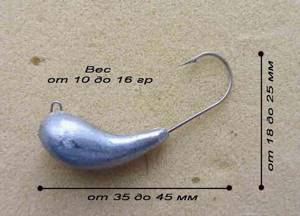
In principle, in conditions of poor visibility, the shape and color of the bait almost does not matter. The vibrations that the pike perch detects with the lateral line are also produced by the ball of the jig head. But at the final stage of the hunt, the pike perch most likely uses its vision, making a dash to the point of attack. The bait (whole or chopped fish) is also important - the striped robber has a well-developed sense of smell. Therefore, the shades of colors are unlikely to change anything. Often fishermen do not paint jigs at all, using ordinary lead jigs. However, phosphorus jigs for pike perch in some places work better than usual - which means that the fanged predator still navigates in the dark and with the help of vision. A common rigging option is to paint the body of a heavy bait with phosphorus varnish and use a light plastic light-accumulating jig on the top suspension.
